Home
A comprehensive resource for safe and responsible laser use
US: FAA warns against aiming holiday lasers into the sky
With the holiday season upon us, the Federal Aviation Administration (FAA) wants to make sure your laser-light displays are aimed at your house and not into the sky.
Each year we receive reports from pilots who are distracted or temporarily blinded by residential laser-light displays. You might not realize this, but a well-meaning attempt to spread holiday cheer has the potential to create a serious safety risk to pilots and their passengers flying overhead.
So please make sure all laser lights are directed at your house and not into the sky. The extremely concentrated beams of laser lights reach much farther than you might realize.
If we become aware that your laser-light display affects pilots, we’ll ask you to adjust them or turn them off. If your laser-light display continues to affect pilots, despite our warnings, you could face a civil penalty.
Laser strikes against aircraft continue to increase each year. Last year we received 6,754 reports of laser strikes against aircraft, a 250 percent increase since we started tracking laser strikes in 2010.
Intentionally aiming a laser at an aircraft is a serious safety risk and violates federal law. Many high-powered lasers can completely incapacitate pilots who are trying to fly safely to their destinations and may be carrying hundreds of passengers.
We work with federal, state, and local law enforcement agencies to pursue civil and criminal penalties against individuals who purposely aim a laser at an aircraft. We may impose civil penalties of up to $11,000 per violation. Civil penalties of up to $30,800 have been imposed by the FAA against individuals for multiple laser incidents.
US: High-powered lasers can be obtained from inside a Christmas holiday laser projector
In a January 22 2018 Hackaday post, Tom Nardi purchased a “Home Accents Holiday Multi-Color Light Projector” from a hardware chain on clearance, marked down from $56 to just $14.
He removed the cover with four screws and found the parts inside used connectors instead of solder: “It’s like they wanted us to strip it for parts.”
The lasers were defocused inside. “…[A]t 3 meters the spots looked as large as dinner plates…. Once focused, it becomes pretty clear that these lasers are quite a bit more powerful than the <5 mW listed on the product’s warning sticker.”
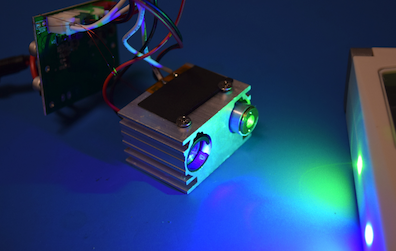
The green and blue laser diode modules inside the holiday projector
Nardi noted that the blue laser, when focused, was “easily able to burn pieces of paper and punch holes in black plastic.” He also estimated that the green laser was “at least twice as bright” as a laser pointer he owns that claims to be 50 mW: “…it certainly would not surprise me if they are both [green and blue] at least 100 mW.”
Nardi writes: “If your biggest take-away from this post is that the Home Depot is selling a 440 nm laser you can use to burn stuff, I certainly don’t blame you.”
From Hackaday. LaserPointerSafety.com has a page with more information, including measurements of the beam output of a Star Shower projector, here.
Commentary from LaserPointerSafety.com: In fairness to Home Accents, the FDA-required warning sticker has to do with the laser power of the unopened unit in its factory configuration. Class 3R (IIIa) laser projectors like this are not allowed in the U.S. to be over 5 mW output power. It may be that after going through the holographic diffraction grating that creates the stars, that the Home Accents projector meets Food and Drug Administration requirements for user access to laser light.
US: FAA issues warning about holiday laser lights
Enjoy Your Holiday Laser-light Display Responsibly
Each holiday season for the past several years, the Federal Aviation Administration (FAA) has received reports from pilots who said they were distracted or temporarily blinded by residential laser-light displays.
The FAA's concerns about lasers – regardless of the source – is that they not be aimed at aircraft in a way that can threaten the safety of a flight by distracting or blinding the pilots. People may not realize that systems they set up to spread holiday cheer can also pose a potential hazard to pilots flying overhead.
So if you’re going to install a holiday laser-light system, please make sure the lights are hitting your house and not shining up into the sky. It may not look like the lights go much farther than your house, but the extremely concentrated beams of laser lights actually reach much further than most people think.
If the FAA becomes aware of a situation where a laser-light display affects pilots, we start by asking the owner to adjust them or turn them off. However, if someone's laser-light display repeatedly affects pilots despite previous warnings, that person could face an FAA civil penalty.
Note: The FAA press release was reprinted in a number of news sources including KUSA, the News Tribune and SFGate.
LaserPointerSafety.com has a separate story about the number of FAA laser incident reports in 2017 due to actual or suspected holiday light displays.
US: Nationwide recall of Santajoy Christmas laser lights sold at Walmart
On Dec. 22, 2017, Santajoy initiated a nationwide recall of Galaxy Holiday Laser Lights and Northern Lights Holiday Laser Lights. These laser projection products may incorporate a laser having a higher output than intended and fail to comply with FDA performance standard requirements (21 CFR 1040.10 and 1040.11). These higher-power lasers have the potential for eye injury.
Consumers who purchased any of the 5,254 units of Galaxy Holiday Laser Lights and Northern Lights Holiday Laser Lights sold by Walmart between August 1, 2017 and October 25, 2017 should stop using them and return them to any Walmart store for a full refund.
The Galaxy Holiday Laser Lights and Northern Lights Holiday Laser Lights were manufactured from May through September 2017 and distributed from August through October 2017. The affected products sold by Walmart can be identified by the packaging photos and UPC numbers shown below.
Santajoy voluntarily recalled these products after becoming aware that the product presented a potential safety hazard and has notified the FDA of this action. There have been no reports of injury related to the use of these products. Santajoy is notifying the public through this press release, and Walmart is accepting the return of these products for a full refund.
Walmart Stores Inc. distributed these products nationwide. Consumers with questions may contact Walmart via telephone at 1-800-Walmart from 7 a.m. to 9 p.m. CT Monday through Friday or online at www.corporate.walmart.com/recalls for more information.
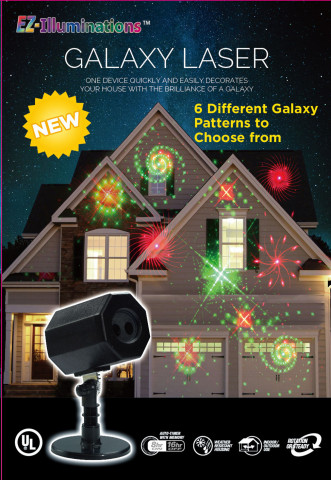
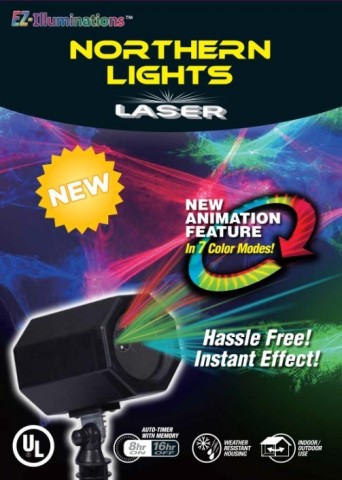
Note: As of January 1 2018, neither laser was listed on the Walmart Product Recalls webpage. The product recall also did not appear to be at FDA’s recalls webpage or enforcement report webpage, as of January 1. The only online source on that date was the December 22 2017 Business Wire press release, or a few publications and news sources such as KCTV that reprinted the Business Wire press release.
US: Amazon aggressively lowers pricing on Star Shower home laser projectors
A December 14 2016 article in the Wall Street Journal describes a price war between sellers of the updated Star Shower Motion, which adds movement to the laser dots.
The list price from Telebrands was $49.99. It appears they lowered the price to around $35, then Amazon and other retailers lowered their prices to $31-33. The wholesale price of the Star Shower Motion is around $30, meaning that Amazon is barely making money on selling this laser projector.
For consumers this may be good news. However, Telebrands is watching a major distributor undercut its own pricing. And, the lower prices are putting more laser projectors in the hands of consumers.
From the Wall Street Journal (subscription required). Summary at Consumerist. LaserPointerSafety has run previous stories about he Star Shower, since they first became popular in 2015. Click for stories about aviation incidents and for general stories about the lights and their potential hazards.
US: FAA Eastern Region warns against holiday & Christmas laser light display misuse
The full text of the statement is as follows:
“The FAA’s concern is that lasers -- regardless of the source -- not be aimed at aircraft where the beams can threaten the safety of a flight. Consumers who buy laser light displays should take precautions to make sure that the lights are hitting their houses and not shining off into the sky. In situations such as this, we would start by asking the person to either adjust them or turn them off. For more information on lasers, please go to www.faa.gov/about/initiatives/lasers/“
From an FAA Eastern Division email to LaserPointerSafety.com, and from the Boston Globe. LaserPointerSafety has run previous stories about Christmas and holiday laser lights such as the Star Shower, since they first became popular in 2015. Click for stories about aviation incidents and for general stories about the lights and their potential hazards.
US: UPDATED - "Star Shower" home laser projector raises aviation concerns
Between November 18 and December 6 2015, there have been at least three incidents, involving six aircraft, where pilots were illuminated with light from “Star Shower” laser projectors. In all cases, the illumination appeared to be inadvertent. The devices were being used for holiday decorating, and stray beams went into airspace. (E.g., a person was not knowingly aiming the Star Shower at an aircraft, or the flight path of an aircraft.)
The Star Shower emits “thousands” of laser beams from two sources, one green and one red. A homeowner can simply aim the Star Shower at her house or foliage, and instantly cover it with green, or green plus red, laser dots.
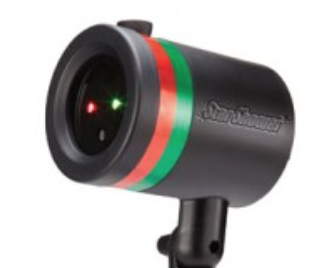
The projector head. It screws into a stake that is placed in the ground for outdoor use.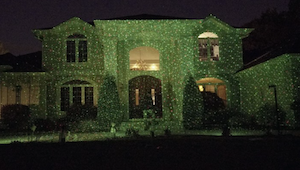
A home densely covered with laser “stars” from multiple Star Shower projectors. Both photos from the Star Shower website.
According to a comprehensive story in Inquisitr, Star Shower is so popular that it is sold out in many locations. TravelPulse calls it a “laser cannon.”
The Federal Aviation Administration on December 8 2015 tweeted “Decorating for the holidays? A stray laser could blind a pilot.” They then provided a link to general information about laser/aviation safety. An FAA spokesperson told CBS Philly, ““I don’t think anybody who buys these devices even think they have enough power to hit an aircraft in the sky…. If the box is aimed a little high, some of the lasers will not hit the roof of the house, they’ll keep going into space.”
While there is no warning on the outer packaging, the Star Shower instruction sheet says: “NOTICE: Lasers should not be projected at or within the flight path of an aircraft within 10 nautical miles [11.5 miles] of an airport. If your intended surface is within 10 nautical miles of an airport, lower the angle of the Star Shower so that no lasers point into the sky.”
In a December 9 2015 statement to NBC Los Angeles, the manufacturer added: “Star Shower Laser Lights operate by taking a single laser beam and diffracting it into thousands of individual laser beams. Each beam emitted by Star Shower is much lower in power than a typical laser pointer. Each individual laser beam is 10 times less than the maximum permissible exposure (MPE) allowed by the FAA normal flight zone (NFZ) criteria.”
In an urban or suburban environment, it is likely that most homes are within 10 NM of some type of airport. It may not be a major metropolitan airport; it could be a small general aviation facility. In a December 3 2015 incident, a Boeing 737 at 13,000 feet and 22 miles east of Dallas-Fort Worth Airport, reported seeing lights from what was believed to be a “laser holiday light display.”
From the FAA, Inquisitr, NBC Los Angeles
Analysis and commentary by LaserPointerSafety.com
ADVICE FOR OUTDOOR USE
After purchasing and testing a Star Shower, here is our summary advice for consumers. Details then follow.
The Star Shower is essentially eye-safe, and does not cause direct interference (glare) with pilots’ vision after about 411 feet. However, a single beamlet can be a distraction to pilots at least 3/4 of a mile away, and possibly further away due to the large number of laser dots aimed into the sky causing a flashing effect.
For this reason, a Star Shower needs to be aimed so that beams don’t go into airspace. You do not want an officer knocking on your door because a pilot saw and reported your home laser projector. While it is unlikely you would be arrested for an unknowing aircraft illumination, federal penalties for laser pointer misuse range up to five years in prison and up to a $250,000 fine.
Putting the projector closer to a house will keep more of the beams on the structure. Similarly, don’t aim it up into a tree unless the tree is very dense, such as an evergreen.
It should also be noted that there are reports such as this and this of Star Showers being stolen from yards. If you put your projector on a roof or up in a tree, aiming downwards, this both helps aviation (no beams going up into the air) and makes it harder to steal the projector. Finally, if you are in a heavy air traffic area, you might want to consider restricting it to indoor use only.
IS A STAR SHOWER LEGAL?
Under U.S. federal law, the Star Shower is legal to own and operate. As a Class IIIa (3R) laser, there are no federal restrictions on its use. The federal law prohibiting laser pointer misuse may not apply, for two reasons. 1) It prohibits knowingly aiming at an aircraft or its flight path, and 2) the law applies to “laser pointers…designed to be used by the operator as a pointer or highlighter….” This definition would not seem to apply to a device that is not a pointer, and is not used “…to indicate, mark, or identify a specific position, place, item, or object.”
A few states or localities may have restrictions on lasers that would affect Star Shower. Since it is not a laser pointer, and is not used for pointing, restrictions that cover laser pointers may not apply (depending on the exact definition). Some selected state and local laws are here.
Common sense says that a person should not stare into the beams, and that they should not be aimed to harass others. Similarly, the beams should not be aimed down a road or up into the sky, where they could interfere with drivers or pilots.
PURCHASING AND PACKAGING
In early December 2015, we purchased a Star Shower for $40 from a CVS drugstore. The box lists a sales website at BulbHead.com, and the distributor as Telebrands. It also says “Made in China.”
Both the box and the device have the proper FDA-mandated laser safety labeling. The device is FDA Class IIIa, meaning less than 5 milliwatts output. There are two apertures, one for 532 nm green laser beams and one for 650 nm red beams. A diffraction grating in front of each laser breaks the single beam into dozens or “thousands” of less-powerful beamlets. In a foggy or smoky environment, it is possible to see the beamlets in the air, but they are too weak to be seen in clear air.
Although the Star Shower has been popular for the Christmas 2015 season, the packaging does not emphasize this. Instead it says the Star Shower is “great for” indoor, landscaping, holiday, winter and summer uses. The advantages are: “No ladders, no hanging, no dead bulbs, no mess — just plug it in.”
TESTING
We took it to laser expert Greg Makhov of Lighting Systems Design Inc. for testing. Keep in mind that he tested just this one sample unit; we assume it is representative of the other Star Showers that have been sold.
Makhov used two different types of power meters, both which could measure in the microwatt and milliwatt region. He found that the maximum power of a single beam was 0.4 milliwatts. The chart below shows details.
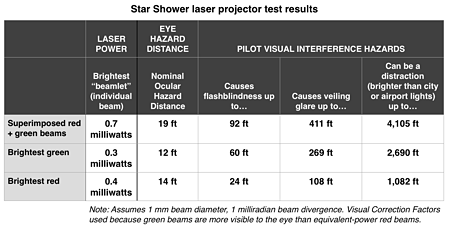
ESSENTIALLY NO EYE INJURY HAZARD
The brightest single beam, at 0.4 mW, is below the 1.0 mW Class II limit. Class II laser pointers are generally considered to be safe for accidental exposure. Eye injury from a Star Shower would be almost impossible unless a person at close range deliberately overcame his aversion to bright light and stared for many seconds into one of the beamlets, keeping it at the same spot in his visual field.
While the chart shows the Nominal Ocular Hazard Distance to be as far as 19 feet, keep in mind this is a “nominal” hazard. This does NOT mean that beams will cause injury at this distance. There is a kind of safety factor built in to the NOHD. A quick approximation is that at about 1/3 the NOHD (about 6 feet in this case), there is a 50-50 chance of a laser kept steady on the eye causing the smallest medically detectable lesion on the retina, under laboratory conditions.
GLARE UP TO 411 FEET, DISTRACTION TO 3/4 MILE
The chart also shows the visual interference hazard distances. For example, a pilot could experience veiling glare (she can’t see past the light) up to 411 feet away from the Star Shower projector. The light does not interfere with vision, but is a mental distraction, up to 4,105 feet away — a little over three quarters of a mile.
The above eye and visual interference calculations are for a single beamlet, for two reasons. First, at aviation distances, only one beamlet would enter the eye at a time. They are not so close together that two separate beamlets of the same color would be within one pupil diameter. The second reason is that even a person is so close to the Star Shower that two separate beamlets enter his pupil, each one will be focused onto a different area of the retina. This means that the beams don’t overlap — they are heating different areas. This is why we are primarily concerned — both for eye safety and for aviation interference — with the hazard of a single beamlet.
Now, when a helicopter flies through the dozens or “thousands” of laser beams, this can be more distracting than a single beam. It is no wonder that a pilot might report the laser display, and have it re-aimed or shut down.
Although an FAA spokesperson said a Star Shower was reported by a pilot who was at 15,000 feet, at this distance any single beamlet would be far below the FAA’s distraction limit. This means any beamlet would be no brighter than surrounding city or airport lights. It could be that the large number of beamlets caused flashes as the aircraft flew through them, and that this flashing was itself a distraction. Either way, no competent pilot at 15,000 feet should have any visual interference from a Star Shower. The only problem could be mental distraction, if the pilot paid more attention to the light than to flying the aircraft.
DISASSEMBLY AND HACKING (UPDATED DECEMBER 2016)
In early December 2016, Julius R. wrote to us wondering about the safety implications of opening the Star Shower and removing the star-creating holographic diffraction grating.
Our Star Shower, purchased in December 2015, has four security screws hidden behind rubber caps. The screws are at the bottom of a 2-1/4” deep shaft that is 5/16” in diameter. The screw head shape is a triangle with a raised dot in the center: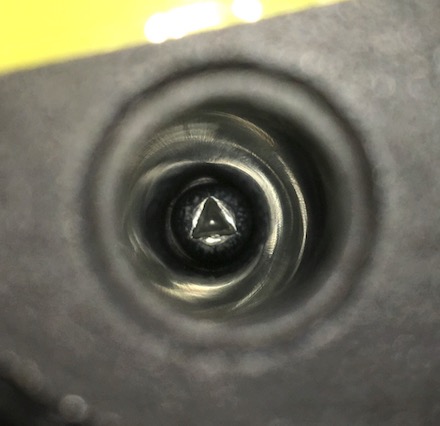
It would require a long screwdriver with a matching tip to reach and undo the screw. A brief search of Google Images to try to find such a screwdriver did not turn up any instances.
Certainly someone might be able to find such a tip, or to grind a shaft to fit. And breaking the Star Shower’s plastic housing could also give access to the inside. So if someone really wanted to get at the interior lasers, it would be possible.
We estimate that each of the lasers on the inside would be in the 10 to 50 milliwatt range. This power can cause an eye injury, although the injury would be relatively minor (assuming an unintentional exposure; deliberate staring into any laser beam should never be done). It is at the low end of Class 3B lasers.
There are similar lasers, and much more powerful ones, readily available online. They would be cost the same or even less, and would be much easier to use. So a laser hobbyist or hacker is unlikely to use a Star Shower as a source for red and green single-beam lasers.
In short, disassembly and misuse of the interior lasers is not a significant safety concern.
FOR FURTHER INFORMATION
Anyone with further questions can contact us; click the link below in the footer at the bottom of the page.